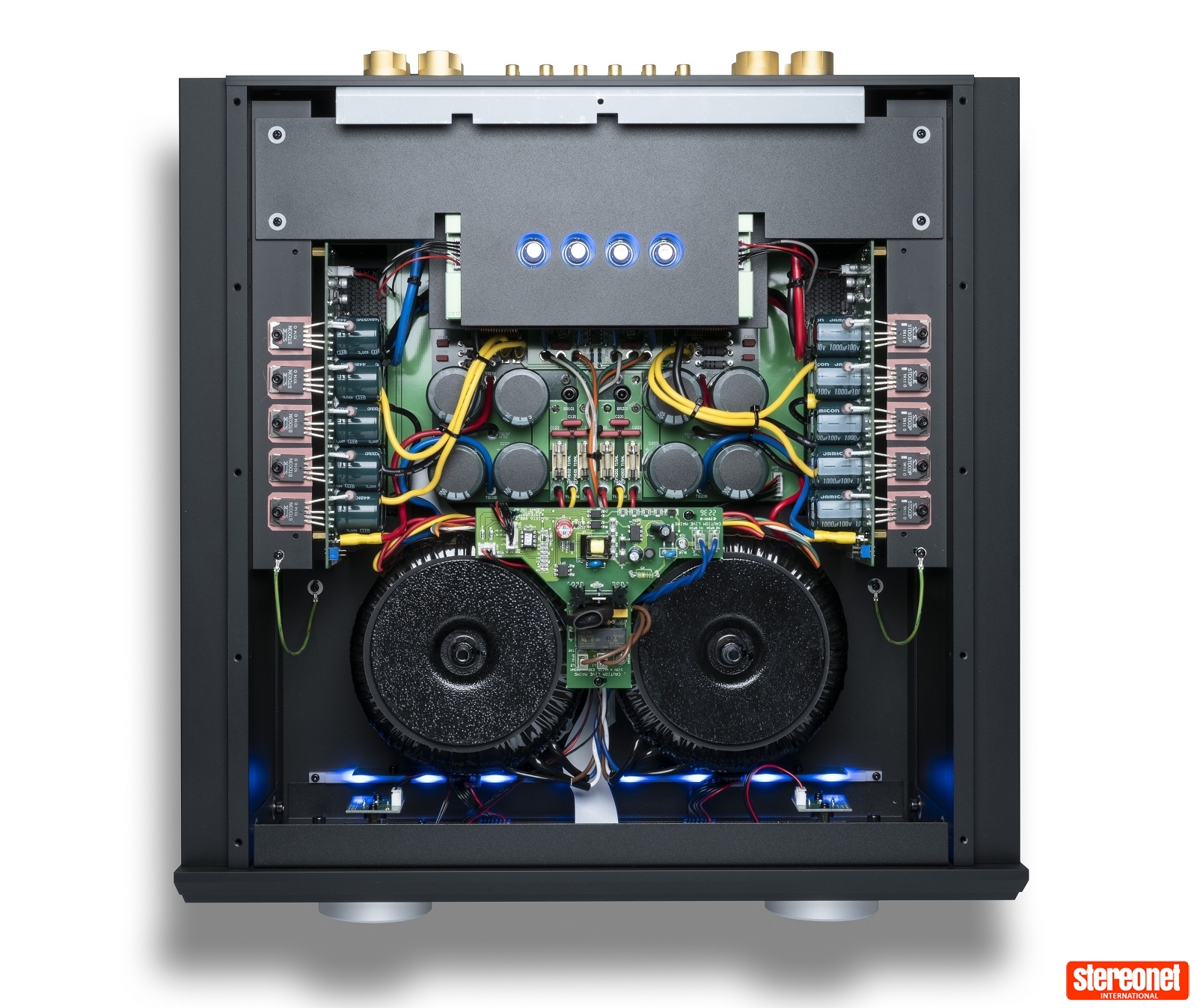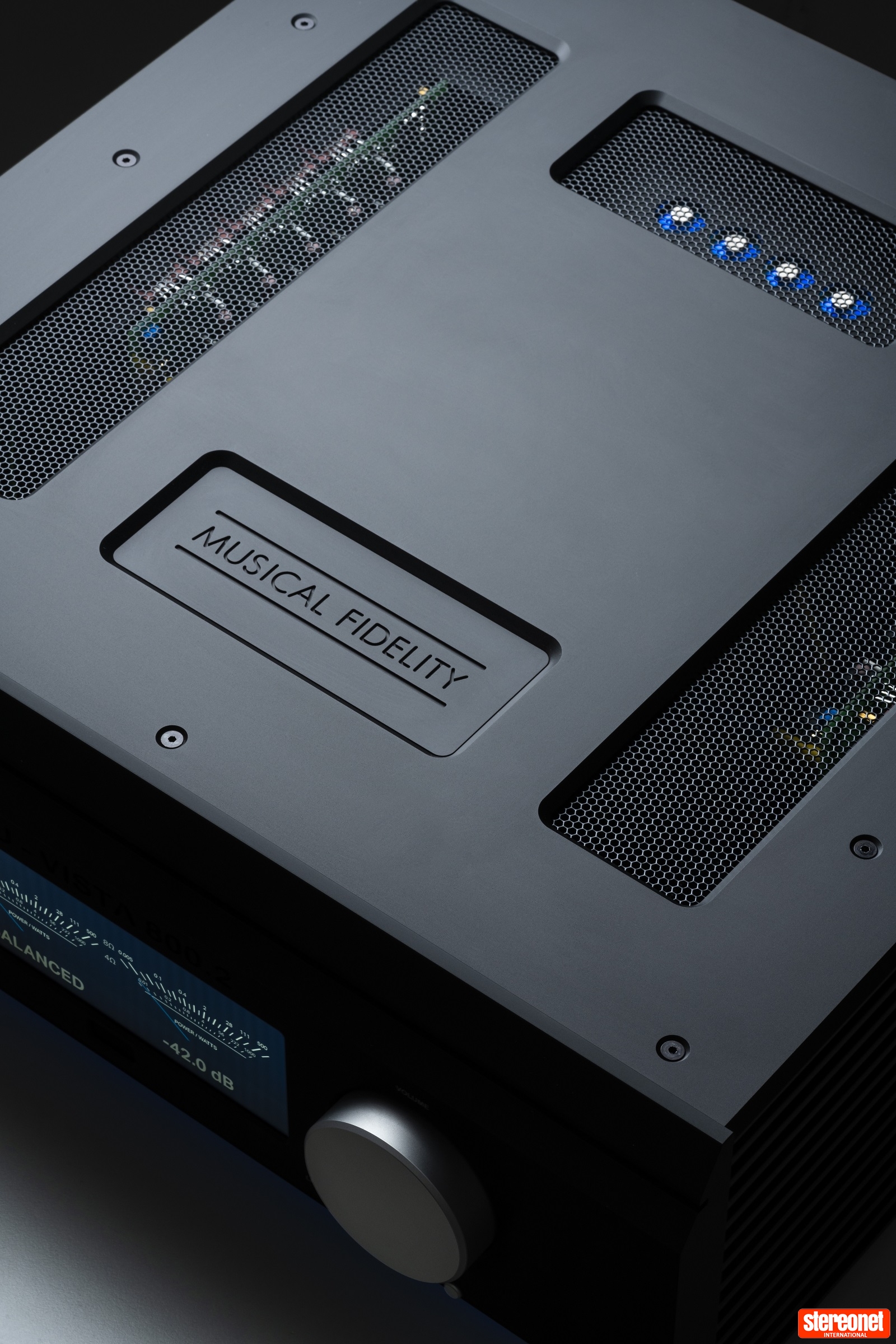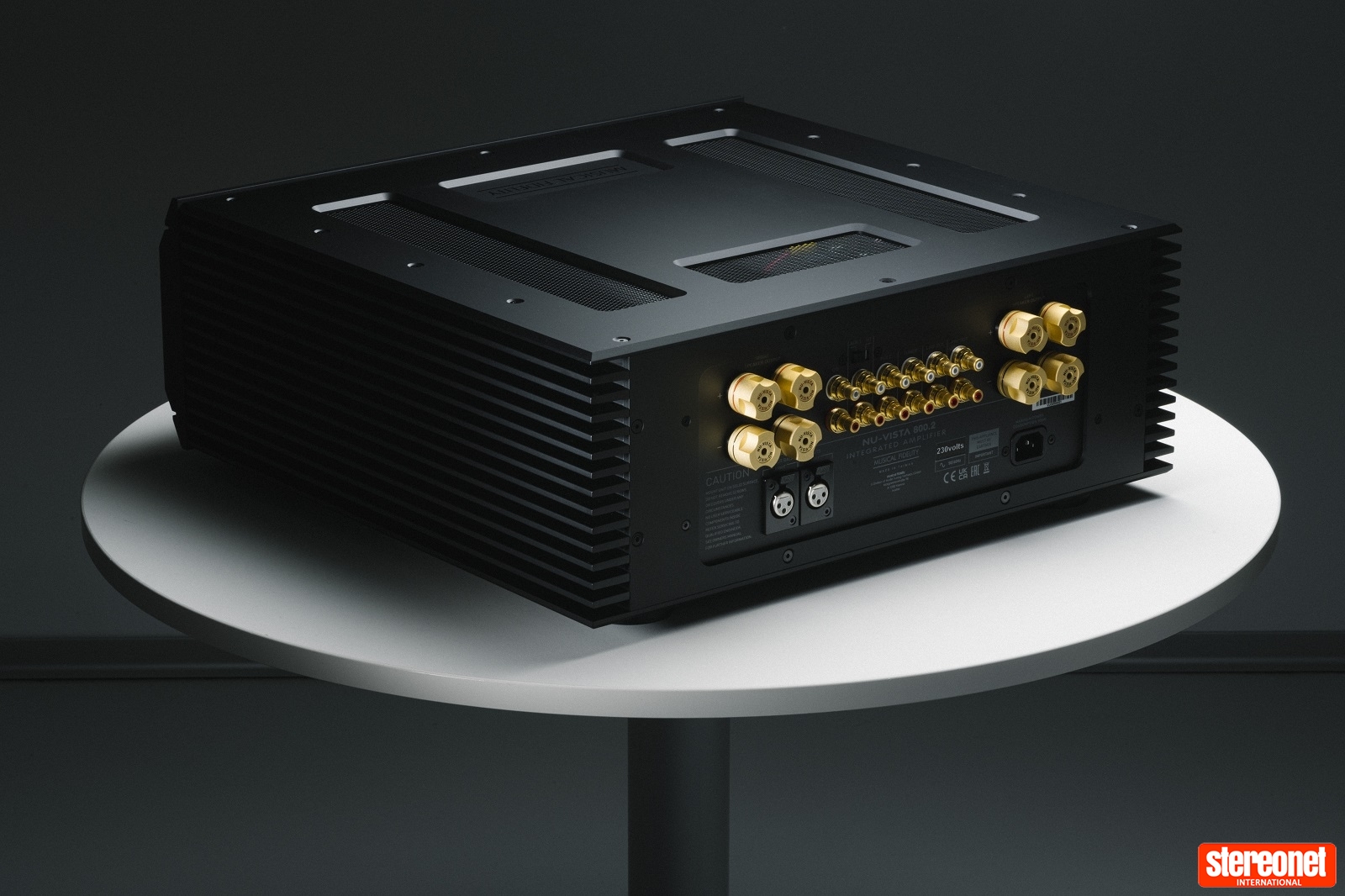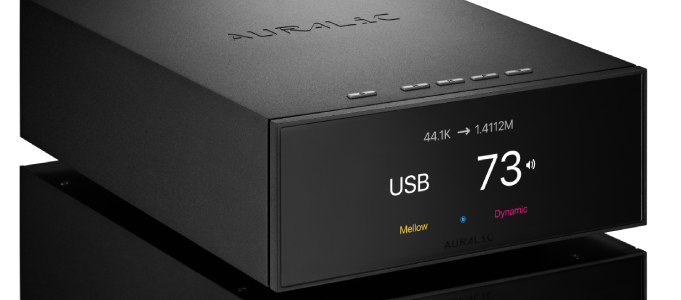Musical Fidelity Nu-Vista 800.2 Integrated Amplifier Review

Chris Frankland auditions this imposing new high-end hybrid amplifier and gets a very nice surprise.
Musical Fidelity
Nu-Vista 800.2 Integrated Amplifier
USD $10,999

Musical Fidelity started making distinctive, high-performance amplifiers back in the mid-nineteen eighties. Since then, of course, the company has expanded its range to include CD players, DACs, streamers, phono stages, turntables and even loudspeakers. The story starts when clarinettist Antony Michaelson joined forces with Kevin Austin in the mid-to-late seventies, going on to form Michaelson & Austin. The brand produced some lovely valve amplifiers designed by the now-legendary Tim de Paravicini. I well remember using the TVA-1X power amp in my system back then – and very good it was too.
Antony Michaelson went on to launch Musical Fidelity as a company in 1984, with the original Paravicini-designed A1 Class A integrated amplifier being its first-ever product. This has since become an affordable audiophile classic. It has recently been revised and resuscitated and is now back in the company's wide range of hi-fi separates. Michaelson duly retired in 2018, and Musical Fidelity was sold to Heinz Lichtenegger's Audio Tuning company, which also owns Pro-Ject.
UP CLOSE
When a product has been so well received, why would you change it? That decision was taken out of Musical Fidelity's hands when, at very short notice, key parts for the Nu-Vista 800 integrated amplifier were discontinued by some suppliers. And so the company decided to respond with the 800.2 reviewed here while leaving as much unchanged as possible from the original winning formula.

The first 800 integrated was launched around nine years ago and much of the same design principles are still evident in today's iteration. Like its predecessor, it is a hybrid design using a valve preamplifier stage and solid-state dual-mono power amps – but it features some rather unusual tubes in its preamp section. Nuvistor valves were invented back in the fifties to address what were seen as some of the pitfalls of conventional tubes. They were said to offer high reliability, low microphony, low noise and improved batch consistency. They were also small and had relatively low power consumption; Nuvistors were famously used in the legendary AEG C12 and Neumann U47 microphones and Ampex MR-70 studio tape recorder.
Four Nuvistor tubes are used in the preamp section of the 800.2, alongside two separate solid-state mono power amps inspired by its Titan amplifier. The 800.2 features locally decoupled output stages, giving each output device its own high-current bulk supply capacitor. These are mounted close to the output transistors in order, says Musical Fidelity, to provide more immediate access to stored energy with a lower impedance path. This, it says, results in better transient response and improved ripple filtering at higher currents.

Believe me, the 800.2 does not skimp when it comes to power, boasting a woofer-wobbling, window-rattling 330 watts into 8 ohms, 500 watts into 4 ohms and 1,000 watt peaks into 2 ohms. There are five output devices per channel, with a peak current capability quoted at 120 amps. Total harmonic distortion is said to be less than 0.005% between 20Hz and 20kHz, with a frequency response from 10Hz to 30kHz.
So what has actually changed in the 800.2? Well, with the need to source a new-look display and front panel, it was also necessary to update the power supply circuits. This also presented the design team with the opportunity to rewind the transformers to achieve lower standing flux, which Musical Fidelity says has made them less sensitive to mains DC offset noise. The new transformers are larger and heavier but still fit the casework.

That case is a massive one, milled from extruded aluminium profiles to help make it more immune from vibration as well as magnetic interference. When setting this amplifier up, I had my chiropractor on emergency standby thanks to its massive 41kg weight! Despite its bulk at 483mm wide, 510mm front to back and 187mm tall, its front panel is tastefully minimalist, dominated by the large central display flanked by two large rotary knobs. The display, when lit, shows two large VU meter-style graphics as well as the input selected and the volume level. The rotary knob to the left selects the input, and below it is an on/off/standby button, while the one on the right adjusts volume, and below that is a button to adjust display and lighting modes.
The back panel sports two sets of gold-plated speaker binding posts, allowing for bi-wiring or bi-amping. Then there are three sets of RCA line level inputs, a fixed line out and volume-controlled preamp out, plus a balanced XLR input. The remote control is a chunky metal device, as befits its pairing with such a behemoth. It controls inputs, mute, power, display and volume. It proved easy to use and showed no annoying quirks. Owners will also notice that in the accessories box, there are four spiked feet with cups and four felt pads. Take your choice as to which best suits the surface you are placing the 800.2 on.

When you switch on the 800.2, you will notice that the Nuvistor valves, visible through a perforated screen at the rear of the amp, glow red. They then change to yellow, and when they are entirely up to operating temperature, they will change to blue, which I found was usually around twenty minutes. A nice touch is that illumination under the front panel's front edge shines down onto the surface underneath the amp. It starts out red and changes to blue when the valves are hot to trot. I think it looks rather classy, but you can turn it off if it annoys you.
To properly sound out the 800.2, I hooked it up to a pair of Russell K Red120Se loudspeakers with Audio Note CDT-Five CD transport and DAC Five Special. In use, the Nu-Vista 800.2 proved straightforward, and selecting the input and volume level using the remote control couldn't have been easier. I also had another hybrid amplifier design of a similar price to hand, which helped me get the Musical Fidelity into a clearer market context…
THE LISTENING
The first thing that strikes you about the sound of this amplifier is its detail, openness and articulation. The way it picked out the guitars in the introduction to Lo Siento Mi Vida from Linda Ronstadt's superb Hasten Down the Wind album was very impressive. This, along with Heart Like A Wheel is one of my favourite albums of hers, and the big Musical Fidelity did it real justice. Recordings from the mid-seventies can be variable, but this one is stunning, and I knew her powerful vocals would be a good test of this Goliath.

There was a great sense of effortlessness in the way that the 800.2 conveyed the power of her voice while keeping it clearly differentiated from backing vocals. Steel guitar was convincingly handled, while the bass line was deep, tuneful and tight, without any sloppiness. This emotion-packed ballad was very well conveyed, and when Ronstadt really let rip, the 800.2 took it in its stride with not even a hint of harshness or glare.
The amplifier's easy power and consummate smoothness, allied with great detail, make it perfectly suited to high-quality recordings such as A Place for Skipper from guitarist Larry Carlton's Discovery album. I was pleased to hear the finesse and poise of the 800.2 on drums and percussion and the insights it gave into how Carlton was playing and shaping each note. The bass line was weighty and powerful but not overpowering, and the track moved along nicely with a good sense of timing.

With the blisteringly fast No One Emotion from George Benson's 20/20 album, the driving bass line on this track moved things along at a good pace – proving that the Musical Fidelity isn't a fat, soggy-sounding super-amp. At the same time, it offered super insight, with the synths and drum machine nicely layered, separated and voiced. The horn section did its thing with poise, power and panache without any undue forwardness, while Benson's vocals were articulate and open. Michael Sembello's exquisite guitar solo was also ably handled, and his fleet-fingered play was well conveyed. All in all, a fine performance.

The 800.2 is a big smoothie then, but this doesn't mean it is dull. The combination of excellent detail resolution, plus great rhythmic and dynamic drive, is pretty special. It was a joy to play one of my favourite albums from ace saxophonist Dave Koz, The Dance, and specifically the track The Bright Side. The 800.2 conveyed the rhythmic impetus of the number well, with bass and drum lines were well carried and Koz's sax had real bite, warmth and power. And when Jonathan Butler came in on guitar and scat vocals, this amplifier brilliantly signposted the skill of his playing and the beauty of his vocals.
THE VERDICT
 Musical Fidelity's Nu-Vista 800.2 integrated amplifier may look like a brute, but don't be fooled by appearances. The simple truth is that it works, sounding well-balanced, musically coherent and easy on the ears. It more than held its own against one of the best transistor amps at this price that I had to hand, as well as against a well-respected hybrid competitor. Capable of driving even the most demanding loudspeakers with ease to high volumes and in large rooms, this amplifier promises much and almost over-delivers.
Musical Fidelity's Nu-Vista 800.2 integrated amplifier may look like a brute, but don't be fooled by appearances. The simple truth is that it works, sounding well-balanced, musically coherent and easy on the ears. It more than held its own against one of the best transistor amps at this price that I had to hand, as well as against a well-respected hybrid competitor. Capable of driving even the most demanding loudspeakers with ease to high volumes and in large rooms, this amplifier promises much and almost over-delivers.
Visit Musical Fidelity for more information
Chris Frankland
One of StereoNET’s most experienced reviewers, Chris has written for a multitude of hi-fi magazines, from Hi-Fi Answers and Hi-Fi Sound, to The Flat Response and Hi-Fi Review. A regular concert-goer, his quest continues to find hi-fi that gets as close as possible to conveying the raw emotion of live music.
Posted in:Amplifiers Integrated Amplifier Applause Awards 2023 Hi-Fi
Tags: musical fidelity focal naim america
JOIN IN THE DISCUSSION
Want to share your opinion or get advice from other enthusiasts? Then head into the Message Forums where thousands of other enthusiasts are communicating on a daily basis.
CLICK HERE FOR FREE MEMBERSHIP
Trending
applause awards
Each time StereoNET reviews a product, it is considered for an Applause Award. Winning one marks it out as a design of great quality and distinction – a special product in its class, on the grounds of either performance, value for money, or usually both.
Applause Awards are personally issued by StereoNET’s global Editor-in-Chief, David Price – who has over three decades of experience reviewing hi-fi products at the highest level – after consulting with our senior editorial team. They are not automatically given with all reviews, nor can manufacturers purchase them.
The StereoNET editorial team includes some of the world’s most experienced and respected hi-fi journalists with a vast wealth of knowledge. Some have edited popular English language hi-fi magazines, and others have been senior contributors to famous audio journals stretching back to the late 1970s. And we also employ professional IT and home theatre specialists who work at the cutting edge of today’s technology.
We believe that no other online hi-fi and home cinema resource offers such expert knowledge, so when StereoNET gives an Applause Award, it is a trustworthy hallmark of quality. Receiving such an award is the prerequisite to becoming eligible for our annual Product of the Year awards, awarded only to the finest designs in their respective categories. Buyers of hi-fi, home cinema, and headphones can be sure that a StereoNET Applause Award winner is worthy of your most serious attention.






